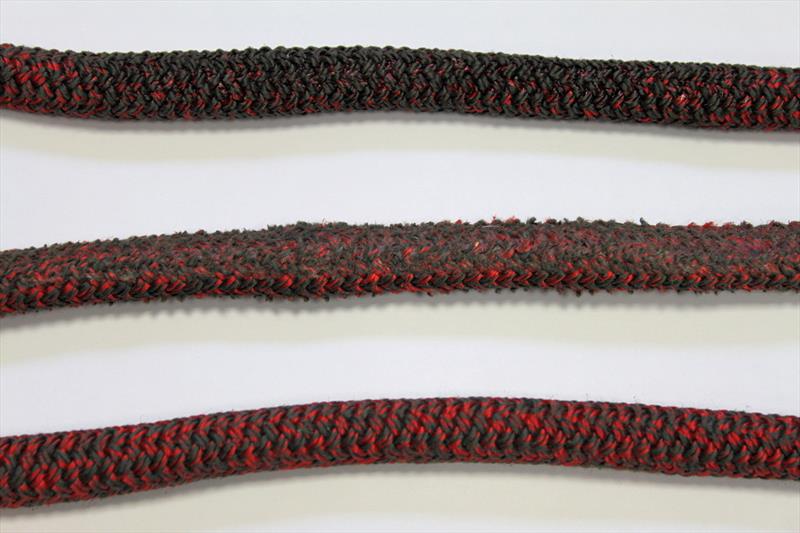
Fatigue and its effect on rope performance
by Marlow Ropes 18 Aug 2017 13:00 BST
18 August 2017

Marlow Tech 50 rope has a technora & polyester blended cover & dyneema core demonstrating the quality as it doesn’t suffer anything like some other ropes would - top: heat fatigue, middle: general abrasion, bottom: normal rope © Marlow Ropes
Paul Dyer, technical manager at Marlow Ropes, examines the effect of fatigue on the performance of rope and rigging.
Ropes, like people, suffer from fatigue. Unlike people a good night's sleep does not reinvigorate them.
What is fatigue?
Fatigue is any mechanism that reduces the performance of a rope over time in service, this can be abrasion, UV damage, creep, bending fatigue or one of many lesser causes. This article will focus particularly on bending fatigue of high performance Dyneema cored ropes.
As modern rope covers are getting more durable including the increased availability of high performance blends, they are lasting longer. Also more applications are appearing on boats that place ropes under higher loads and perhaps on small sheaves. All this is resulting in fatigue becoming more relevant to sailors, riggers and boat designers than ever before.
A rope is made up of twisted yarns and each yarn contains hundreds of filaments. Every time a rope is flexed the fibres slide across one another, causing the filaments to abrade and eventually to break, thus reducing the strength of the rope. This is a cumulative process and if unchecked the rope will eventually have a strength less than the working load resulting in an in-service failure.
You can read far more about the different rope technologies on the Marlow website here.
There are many factors that influence fatigue, these include:
- Material: Most modern high performance ropes have a Dyneema core, this material has good fatigue resistance. All the following information is based on testing of Dyneema 12 strand ropes.
- D:d ratio: This is the ratio of the diameter of the rope to the diameter of the sheave the rope is being bent around. The larger this is the better the fatigue life, a small increase in D:d can significantly improve the rope's life. In the graph below a doubling of the D:d ratio will approximately triple the fatigue life (note the logarithmic scale on the y-axis).
- Load: like D:d the load a rope is under can significantly alter the fatigue life. In the graph below a 35 percent increase in load will halve the fatigue life. In this example the rope is a 4mm diameter with a minimum break load of 1850kg so the highest load tested is only 25% of the break load.
- Coatings: Most HMPE ropes have a coating or impregnation of some sort, normally this is there to improve handling, splicing, abrasion resistance and to impart a colour to the rope. These coatings can also alter the fatigue life, with some standard PU coatings actually reducing fatigue life. Special lubricating coatings can extend the rope's life significantly.
- Rope design: Factors such as twist level, braiding pitch etc can all have an effect on the fatigue life of a rope.
How can rope designers and users make sense of all these parameters?
One method is to combine the Load and D:d into a single "life factor" by multiplying the coefficient of utilisation (safety factor) and the D:d ratio. I.e. a rope with 1000kg MBL working at 200kg on an 8:1 sheave will have a life factor of (1000/200)x8 = 40.
Combining these parameters allows us to compare the major factors on a single chart for each rope design, the chart below is an example of this for Marlow D12:
With this data we have a tool by which we can start to make judgements as to how a systems design will affect the life of the rope and how long that rope can remain in service.
Other factors to take into account:
- Pre-stretching: This does not significantly alter the fatigue properties but it does reduce the diameter for a given strength, which effectively alters the D:d (if used on the same sized sheave) and therefore the life factor. What this means is that compared to a non pre-stretched rope swapping to a stronger heat set rope at the same diameter will give a small improvement in the fatigue life, while swapping to a smaller rope with the same strength will give a small reduction in the fatigue life.
- Heat: As the rope is cycled, heat is generated in the braid and the faster the cycling the more heat builds up. At small diameters this isn't a problem and cycle speed doesn't affect the life. However, at larger diameters the heat generated at higher cycle speeds can affect the fibres, reducing the fatigue life. In extreme cases it would be possible to melt a rope's core though the heat generated!
Rope fatigue is a huge subject and this article only scratches the surface. However Marlow's extensive and continuing test program in this area not only means that our ropes are designed to optimize performance, but that we are able to offer clear technical and application advice, based on empirical evidence as well as race proven results.
Marlow Ropes is a trailblazer in the technical development of leisure marine ropes from dinghies to super yachts and particularly service high-speed sailing with its Marlow Grand Prix (MGP) range. Marlow designs and produces customised ropes and rigging for any number of applications including being the official supplier to the British Sailing Team, the US Sailing Team, and the Clipper Round The World Yacht Race.
www.marlowropes.com